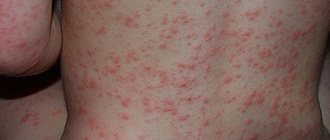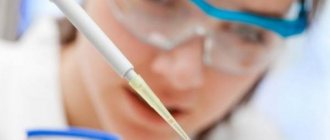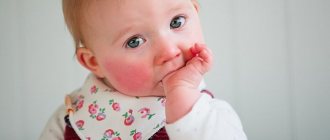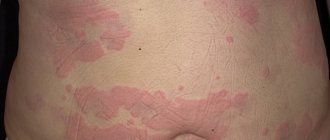December 21, 2021
Urticaria is an unpleasant and sometimes frightening disease of an allergic nature, accompanied by itchy skin rashes
Urticaria is an unpleasant and sometimes frightening disease of an allergic nature, accompanied by itchy skin rashes. The sensation is reminiscent of a nettle burn, hence the origin of the name of the diagnosis. Treatment of urticaria can never be done without the use of various antihistamines, because the bright and disturbing symptoms do not allow patients to delay therapy.
Fortunately, modern pharmacological agents are highly effective and act very quickly, so relief is almost instantaneous.
Treatment of allergic urticaria in adults
Allergic urticaria is a dermatological reaction to exposure to a factor with a protein structure.
The disease is characterized by increased immune reactivity and is accompanied by specific rashes similar to nettle marks. In 40% of adult patients, the condition is combined with symptoms of angioedema1. It is characterized by isolated swelling of a part of the body with the formation of dense edema affecting the subcutaneous fat and dermis of the skin. Urticaria affects approximately 15-25% of the population, and in 30% the disease is chronic4.
The disease requires complex treatment aimed at eliminating the allergen from everyday life and blocking the mechanisms that provoke the formation of the rash. Ignoring the problem is dangerous, as the condition progressively worsens, up to anaphylactic shock. In addition, this type of allergy significantly worsens the quality of life and can cause psychological problems and neuroses.
The best enterosorbents for urticaria
In addition to combating the visible manifestations of an allergic reaction, urticaria is treated from the inside. To do this, enterosorbents are used, which will remove allergens, toxins and other harmful substances from the body. We analyzed the latest offers on the pharmaceutical market, the level of demand, and doctors’ recommendations. Based on reviews, effective remedies for urticaria were selected.
Smecta
An effective sorbent for cleansing the body of toxins and allergens. An antidiarrheal drug with adsorbent properties, where the active ingredient is dioctahedral smectite. Efficiency is observed against viruses and pathogenic microorganisms. Available in individual packaging of 3 g, one dose, inside there is a powder with orange or vanilla flavoring. It differs from many analogues in that it is used from the first days of life, during pregnancy and lactation. The component also stimulates the production of mucus in the intestines, increasing the protective functions of the immune system. In difficult situations, treatment with Smecta is prescribed for 7 days. The price of 10 bags is 140-170 rubles.
Advantages:
- For all ages;
- Pleasant taste;
- Allowed for pregnant and breastfeeding women;
- Increased intestinal immunity;
- Rapid removal of allergens;
- Inexpensive.
Flaws:
- Lumps during dilution;
- Reduced absorption of other drugs.
Adult patients are prescribed to take up to 6 sachets during the day, a child can take no more than 2 doses (you can mix the powder with food and drinks). For better absorption, it is better to carry out manipulations between meals. Smecta is not prescribed to those who suffer from chronic constipation or intestinal obstruction.
Polysorb
Another popular remedy for urticaria in adults and children is Polysorb from a Russian pharmaceutical company. The main substance is colloidal silicon dioxide, which binds and then removes all harmful substances from the body. It differs from analogues in its strong sorption and detoxification properties. Thanks to this, the medication is widely used in complex treatment. Release form: odorless, tasteless powder for dilution with water and oral administration. Enterosorbent is approved for children of any age; in this case, the dosage is selected taking into account weight. The instructions allow the use of Polysorb by pregnant and breastfeeding women. One can of 12 g costs 50-80 rubles.
Advantages:
- Treats any form of skin disease;
- Quick elimination of the clinical picture;
- Allowed for children, pregnant and breastfeeding women;
- Safety;
- Ease of use;
- Inexpensive.
Flaws:
- There are contraindications;
- Makes it difficult to have bowel movements.
At least 60 minutes should pass between Polysorb, other drugs and food. If the cause of the allergic reaction is food, then the sorbent is taken before eating. The maximum duration of the course is 2 weeks. Polysorb is not recommended for people with acute inflammation of the digestive system, intestinal atony, or intestinal obstruction.
The best remedies for psoriasis
Causes of urticaria in adults
Allergic rashes are caused by the following environmental factors:
- Food (seafood, nuts, chocolate and other products containing cocoa, honey, eggs, dairy products, citrus fruits, exotic fruits, strawberries and other berries, various herbs for herbal tea);
- Medicines (penicillin antibiotics, acetylsalicylic acid and other NSAIDs, B vitamins, vitamin C, non-narcotic painkillers and any other medications in the form of individual intolerance);
- Insect bites: bees and wasps;
- Animal fur, saliva (by inhalation, bites or scratches);
- Plant pollen (rarely manifests itself as urticaria);
- Mold.
Sometimes the factor that caused the allergy is obvious due to the direct connection between the appearance of the rash and its exposure. For example, after eating a certain product. In some cases, it is not possible to determine the allergen on your own, so you have to conduct specific studies.
The best ointments for urticaria
The main therapeutic measure against urticaria is the use of local drugs in the form of ointments or creams. They can be prescribed as the only drug for mild forms of the disease, or in combination with other drugs in difficult situations. Unlike tablets, ointments are less harmful to the body and act precisely on the source of the disease. We have selected the best drugs for the treatment of urticaria in the form of ointments.
Advantan
Italian highly effective hormonal preparation for rapid skin restoration. The active component is methylprednisolone aceponate from the group of local glucocorticosteroids. Prescribed to relieve the inflammatory process and suppress an allergic reaction. Advantan was included in the rating due to its high degree of safety, good combination of water and fat, and its acceptability in pediatrics for the treatment of children from 4 months. Packaged in aluminum tubes of various sizes. The ointment effectively eliminates swelling, itching, redness, and quickly heals scratching wounds. Price from 500 to 700 rubles.
Advantages:
- Thoughtful composition;
- Economical consumption;
- Performance;
- Good tolerance;
- Allowed for children from 4 months;
- Treatment during pregnancy is acceptable.
Flaws:
- Price;
- Risks of developing glaucoma.
Apply the ointment in a thin layer no more than once a day. The maximum period of treatment for children is a month, for adults – 3 months. Positive changes are observed already in the first days of application. The price is justified by economical consumption and minimal risks of developing undesirable manifestations.
Zinc ointment
A safe ointment for urticaria, especially for the treatment of children, women during pregnancy, and breastfeeding. It is harmless to health; unlike the previous nominee, it is a natural non-hormonal remedy. The main substance in the composition is zinc oxide. Guarantees antimicrobial, anti-inflammatory effect. Regular application eliminates itching, irritability of the upper layers of the skin, and swelling. For greater effect, it is recommended to use the ointment immediately after identifying the first symptoms on the face or body. There is no addiction syndrome or side effects expected here. There are no age restrictions, the average price is 50-70 rubles per tube with a capacity of 10 g.
Advantages:
- Safe composition;
- Wide range of purposes;
- No contraindications;
- Suitable for children, pregnant and breastfeeding women;
- No addiction;
- Price.
Flaws:
- A greasy white layer that stains clothes;
- The effect is only in the initial stages.
A thin layer of ointment should be applied to the damaged areas for about 10 days in a row. It is advisable not to rub, repeating the manipulations 2-3 times a day. The only contraindication is intolerance to the component, which may intensify the allergic reaction.
How to recognize the disease and identify its causes?
Urticaria on the body of an adult has characteristic signs:
- The rash appears immediately after exposure to the allergen, within a few minutes, and goes away just as quickly, often within a day.
- The rashes are most often localized on the arms, legs, and body, but can occur on any part of the body.
- The rash is characterized by the appearance of blisters that rise above the surface of the skin, pale pink or reddish in color, with clear contours. Blisters can merge into large spots.
- The rash is accompanied by severe itching3.
You can identify the cause of the rash yourself if you track the factor that causes specific symptoms to appear. However, the connection is not always obvious, so laboratory tests have to be carried out to accurately determine the allergen. They are called provocative tests. Investigations should not be performed during an exacerbation4.
Check yourself: classic symptoms of urticaria
- First, pink or red itchy spots appear on the skin, which are covered with papules, vesicles, and blisters. Spots can migrate and change.
- These angioedema can be of any shape and size and are prone to coalescence and combing. Traumatization of the epidermis is accompanied by infection, the development of dermatitis, and the addition of various microflora (bacteria, fungi).
- Severe itching occurs, but with each touch of the affected area, the urticaria becomes more pronounced.
- Sometimes the body temperature rises, aches and headaches occur.
- The disease can be complicated by Quincke's edema: difficulty breathing, swallowing, nausea, vomiting, increased lip volume, swelling of the eyes, and then the entire face, which only increases. Mucous membranes are pasty, loose, swollen.
If anaphylaxis begins to develop, it is important to urgently call an ambulance.
Urticaria in children sometimes occurs without other symptoms other than changes in the skin, but more often develops after the onset of exudative diathesis. The likelihood of developing pathology is higher in children who receive artificial feeding and some foods that are not yet appropriate for them by age.
Urgent Care
Algorithm of action in the event of a sudden allergic reaction with characteristic rashes:
- Immediately stop contact with the allergen, if possible. If we are talking about food or medicine, then the use of sorbents is recommended. It is not advisable to perform gastric lavage on your own due to the risk of Quincke's edema. When bitten by insects, it is recommended to limit the spread of poison and remove the sting.
- Taking second generation antihistamines. One of the recommended drugs, which begins to act after 20 minutes, is Cetrin. The active substance Cetirizine is characterized by high efficiency and reduced side effects, including drowsiness2.
- If signs of breathing problems, changes in heart rate, drop in blood pressure, or signs of Quincke's edema appear, you should immediately call an ambulance4.
Treatment of urticaria in adults is carried out immediately after the onset of symptoms. Delay can cause life-threatening complications, especially with continuous exposure to the allergen.
Rating of remedies for urticaria
The VyborExpert project team has done a lot of work to study doctors’ recommendations on the best way to treat urticaria in children and adults. I also reviewed offers from pharmaceutical companies popular in pharmacies. Several dozen applicants were considered, each assessed on a group of criteria:
- Type – antihistamines, hormonal, sedatives, sorbents, external, internal;
- Release form: tablets, capsules, ointments, creams, syrups, solutions;
- Treatment regimen – method of administration, frequency, course duration;
- Efficacy – speed of onset of relief, digestibility, bioavailability;
- Age – admission to children, adults, elderly people;
- Contraindications – a list of restrictions for use;
- Risks – the likelihood of side effects;
- Special instructions - pregnancy, lactation, compatibility with other medications;
- Manufacturer – imported, domestic drug;
- Price - the cost of packaging, whether it is enough for the course, the relationship with effectiveness.
As a result, we selected 7 nominees who received the best recommendations from dermatologists and experts. They demonstrate maximum demand and high patient ratings. Real reviews helped determine the strengths and weaknesses of each candidate and confirmed its benefits in the fight against urticaria.
Features of the diet for urticaria
Nutrition is a very important part of successfully recovering from the disease. Regardless of the cause of the rash, it is recommended to adhere to a hypoallergenic diet during an exacerbation. Diet principles:
- Complete exclusion of the product that caused the allergic reaction and any food similar in nature.
- Refusal of products containing chemical additives and preservatives, which can aggravate the course of the disease.
- Refusal of products with dyes, even if they are natural.
- Exclusion of generally recognized allergenic products (nuts, seafood, chocolate, honey).
- Food must be balanced and contain the necessary complexes of macro and microelements.
- Avoid alcohol, as it aggravates the symptoms of the disease.
The best sedative for urticaria
Frequent companions of urticaria are nervousness, irritability, and insomnia. To reduce excitability without causing complications, the dermatologist prescribes sedative medications. Preference is given to safe sedatives that do not harm the nervous system and other internal organs. After analyzing expert advice, patient reviews, and clinical studies, we have chosen one undoubted leader in this rating category.
Persen Forte
A sedative from a Slovenian pharmaceutical company with an increased concentration of active substances. The main difference between this nominee and all those described above is its herbal composition without synthetic additives. To relieve irritability and have an antispasmodic effect, Persen Forte included lemon balm, peppermint, and valerian. It is prescribed for any diseases accompanied by increased irritability. Release form: small red-brown capsules for swallowing orally. Treatment is allowed from 12 years of age. The package contains 40 tablets, their price is 300-350 rubles. Pregnant and breastfeeding women need a doctor's permission.
Advantages:
- Plant origin;
- Convenient capsules;
- Getting rid of nervousness;
- Quick tangible effect;
- No addiction syndrome;
- Doesn't make you sleepy.
Flaws:
- Price;
- Adults only.
Take Persen Forte if urticaria is caused by stress, 1-2 capsules up to 3 times a day. The course of treatment depends on the complexity of the disease, from 2 to 8 weeks. Despite its plant origin, patients observe the effect already in the first days of therapy. In rare cases, a long course provokes constipation.
Drug treatment of allergic urticaria
Taking medications is necessary for both acute and chronic cases. The following groups of drugs are used:
- Antihistamines. Cetrin is a second-generation drug that blocks histamine receptors, helping to eliminate the symptoms of allergic urticaria. The drug is used once a day, as it is effective for 24 hours. The drug begins to act within 20 minutes after administration2.
- Enterosorbents. Eliminates the allergen from the gastrointestinal tract, which is why it is not absorbed into the blood.
- Corticosteroids. Taken in severe cases of allergies as prescribed by a doctor and as an emergency aid to relieve Quincke's edema1.
Treatment of the disease in adults should be comprehensive, aimed at completely eliminating irritating factors. Antihistamines are drugs indicated for any form and severity of an allergic reaction.
Forms and complications of urticaria
Urticaria is divided into acute and chronic.
Diagnosis of these forms is based only on the duration of continuous rashes. The limit is 6 weeks of rash.
Acute urticaria , as a rule, does not require any special examinations, with the exception of suspected allergies. In this case, allergy testing with the suspected allergen (eg food) may be required. Most often, acute urticaria is provoked by infections such as ARVI.
If the rash does not stop within 6 weeks, the development of chronic urticaria . Chronic urticaria, in turn, is divided into:
- induced (factors - cold, sun, water or others);
- idiopathic (neither the patient nor the doctor can determine the causes of the rash).
Urticaria or the so-called urticaria-like rash (med. - similar to urticaria) can also be a nonspecific manifestation of some common diseases.
The doctor will help determine the form of the disease and prescribe the necessary examinations and treatment. According to international guidelines (guidelines), numerous and detailed examinations are not carried out for patients with urticaria. If the urticaria is induced, the cause of the rash will be determined at the initial appointment. In most cases, urticaria is idiopathic—it is not caused by diet or lifestyle.
Hives can be one of the manifestations of severe allergic reactions.
In these cases, it occurs simultaneously with symptoms such as swelling (angioedema), shortness of breath and difficulty breathing (bronchospasm), vomiting, diarrhea, decreased blood pressure, lethargy, weakness - even loss of consciousness. In this situation, emergency medical care is necessary.







